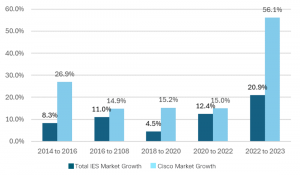- 10 must-try Google Photos tips and tricks - including a new AI editor
- AI could erase half of entry-level white collar jobs in 5 years, CEO warns
- Is all this data about our health good for our health?
- Why I prefer this Lenovo tablet over the iPad for multimedia consumption - and it's $130 off
- This Android tablet brings a $1,700 iPad Pro feature to the $400 price range - and it's just as good
From security to AI: factors that are driving industrial networking investment

In recent years, industrial networking sales have experienced a remarkable surge, driven by the convergence of several pivotal technological advancements. A new ARC Advisory Group ARCView paper describes that the demand for robust and reliable networking solutions in industrial environments is higher than ever, and three key factors are at the forefront of this growth: embedded security, IT-OT integration, and artificial intelligence (AI). You can access the ARC report here.
At Cisco, we have been building industrial networking solutions that are closely aligned with these three core customer demands. We integrate security directly into our industrial network devices, with visibility, segmentation, and zero-trust remote access built as software functions right into our switches and routers. These network devices also facilitate seamless management and data exchange between IT and OT domains, powering a reliable, high-performing network that efficiently collects and transports operational data to AI applications in data centers and the cloud.
What customers want
In the ARCView paper, Chantal Polsonetti, Vice President, Advisory Services at ARC, writes that organizations increasingly view the network as a critical enabler of the digital transformation necessary for meeting mounting macroeconomic, competitive, and regulatory challenges. According to her, “OT cybersecurity is increasingly gaining the attention of CIOs as the industrial threat surface expands. The burgeoning market for AI-enabled applications and processes extending from the enterprise to operational environments is fueling even greater emphasis on networks as a core foundation for business success.”
The latest Forrester WaveTM report provides additional support for ARC’s viewpoint. Given the increase in devices and smart OT initiatives, organizations are searching for integrated solutions to bridge the gap between IT and OT security. The report underscores the network as a vital component in streamlining detection, investigation, and protection across both domains.
“Industrial networks are vital strategic components for addressing today’s macroeconomic, competitive, and regulatory challenges. A converged approach that incorporates IT, OT, and security requirements for centralized management and visibility is necessary to ensure secure, resilient communications from the production environment throughout the enterprise.”
– Chantal Polsonetti, Vice President, Advisory Services at ARC
The ARCView paper emphasizes how the three factors are not isolated, but organizations need to see the network as an extension of their cybersecurity infrastructure. Incorporating OT, IT, and security priorities into the network equipment itself eliminates the need for point products, simplifies network’s deployment and management, and helps eliminate gaps in defense.
Recognizing the network’s central role in industrial operations, the paper stresses that as operations are increasingly targeted with cyberthreats through the network, it is important for the network itself to be able to recognize and report such attacks. Making this point, the paper mentions, “Customers need to connect and protect their industrial assets with solutions that enable the convergence of networking and security, simplify and standardize network management, and leverage software capabilities to automate tasks and enhance visibility”.
Figure 1: Cisco views the industrial network as the fabric to enable OT security at scale
The paper notes that legacy systems, point solutions, and multiple management systems create significant operational complexity limiting scalability and increasing security vulnerabilities. Therefore, the paper suggests, “Industrial network standardization is the key to unlocking advanced software capabilities at scale, including automation, threat defense, network management, and new requirements for industrial AI use cases”, and that “Many current installations are made up of a patchwork of difficult-to-scale point-based solutions acquired individually over time to meet the needs of specific applications or processes”. The key to removing point solutions, thereby simplifying the architecture and improving security, is to embed security functions within the network itself as software applications.
“Industrial network standardization is the key to unlocking advanced software capabilities at scale, including automation, threat defense, network management, and new requirements for AI use cases.”
– Chantal Polsonetti, Vice President, Advisory Services at ARC
Organizations also recognize that IT/OT convergence achieved through the network can significantly improve data flow resulting in enhanced operational efficiency and providing the foundation for AI-driven innovation. The paper explains that a converged network must meet the requirements of IT, OT, as well as security teams. “Centralized management and visibility of security operations and unified visibility into IT and OT security events are essential for a converged approach, with customers increasingly leveraging IT-oriented approaches to this end”, the paper explains.
Cisco’s leadership and commitment
What struck me from this report is how similar their findings are to our own experience at Cisco. We recently surveyed over 1,000 professionals in 17 countries operating in 20 industrial sectors. We conducted and published the 2024 State of Industrial Networking Report.
Building on four decades of building innovative solutions for enterprise networks, we have extended our leadership to industrial networks. Our deep understanding of connectivity, security, and scalability allows us to bring enterprise-grade reliability and innovation to the industrial sector, while still addressing the core needs of the industry.
Our customers agree. According to the report, over the past decade, Cisco’s growth has outstripped that of the total Industrial Ethernet market. Our alignment with the evolving needs of the modern industrial environment ensures that our customers can achieve greater operational efficiency, security, and innovation.

Figure 2: Cisco’s growth has outstripped that of the total IES market since 2014
(Source: ARC Advisory Industrial Ethernet Switches Market Outlook)
Read the full ARCView paper available at no cost. For more information and to set up a no-obligation free consultation with one of our industry experts, please fill out our contact form and we will be in touch, or visit Cisco Industrial Switches.
Share:

